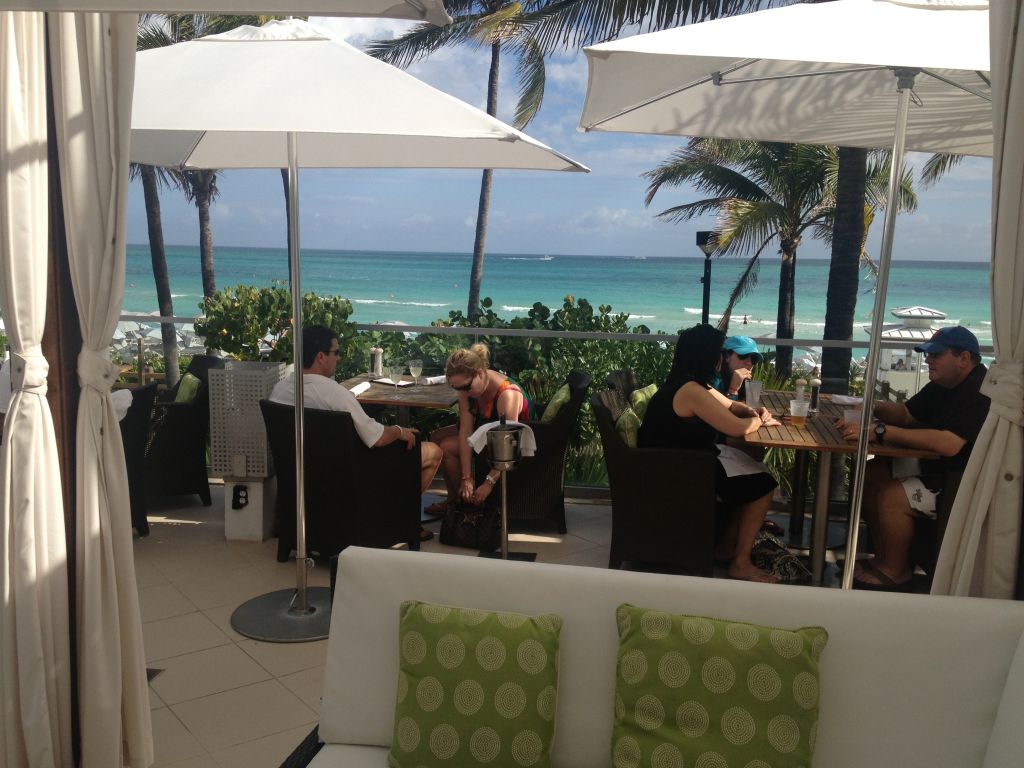
South Beach Food Scene Offers More Than Poolside Burgers

MIAMI, FL – We had come to relax, and eat of course, but there was never a plan to perch ourselves poolside at the Delano for $600 a night and drink overpriced mojitos. This time, my goal in South Beach was to see what all of the writers and chefs have been talking about, rather than play catch-up with the hottest new club at the latest Art Deco hotel along Ocean Avenue. I was here last February, during the SoBE Food & Wine Weekend, er, party on the beach. A Southern Wine & Spirits-led event that has a dizzying number of cookouts, classes and meet-and-greets under the sun. I remembered one night, I had dinner at the 59-year-old Fontainebleau Hotel, which underwent a $1 billion renovation a few years ago. The main lobby looked like the Bellagio, and the dinner choices were impressive: London’s Hakkasan (modern Chinese), New York’s Gotham (steak) and Scarpetta (Italian).
This year, I wanted something with a little less production value, but still high-quality. Celebrity chefs have come to Miami in droves. Jean-Georges and Daniel Boulud have descended from New York City, while local girl Michelle Bernstein continues to be inspired by local farmers at her namesake, Michy’s, which still produces inventive, modern American with Latin and Asian accents. Andrew Carmellini has had success in New York with Locanda Verde, but the Miami offshoot of The Dutch – an American-inspired Kennedy-meets-Martha-Stewart roadhouse inside the W Hotel – is as good a reason as any to indulge in mammoth seafood platters and delicate pappardelle pasta with silky sheep’s milk ricotta and fresh mint; I would go back just for the custardy banana cream pie:

José Andrés also opened up a second Bazaar here (the other is in Beverly Hills), in the SLS Hotel on Collins Drive, where Spanish-influenced modernist cuisine reigns like a matador at high noon. But be careful, you can easily spend a month’s rent (or mortgage payment) if you keep on ordering from the tapas-inspired menu. The valet alone was $30.
Perhaps the best-known “name” chef here though, is Michael Schwartz. Every chef, writer and food fanatic I consulted with before traveling implored me to make the trip to Michael’s Genuine Food & Drink. Tucked among high-end clothing shops and furniture galleries in the Design District, just a few miles west of the beach, the meal I had there was both sophisticated, and yet simply delicious. Snacks ranged from mustardy deviled eggs to rich, chicken liver mousse shmeared on crostini. Linguine, embedded with sausage, fennel, roasted cipollini onions and bits of Swiss chard was a paean both to local produce and artisan foodways:

For lunch the next day, I checked out Yardbird, a relative newcomer in South Beach, just a block or so off of tourist-heavy Lincoln Road. A serious bourbon list puts you in a Southern frame of mind, but when the shallow bowl of Florida shrimp and South Carolina grits arrives in a deep, dark pool of veal stock fortified with beer, garlic and red wine, you’ll know immediately where the chef’s heart lies. That, and the fact his ultra-crispy, impossibly moist fried chicken with a sidecar of spicy Tabasco honey will render your knees weak:

The other restaurant I had heard a lot about was Pubbelly. Imagine the lovechild of Japanese and Korean ingredients, informed by one of the owner’s Puerto Rican roots. Nearly every dish features some sort of pork belly, either as a fork-tender block swimming in an umami-rich bowl of ramen, or embedded into kimchi fried rice; it even shows up in a side of mofongo – the Puerto Rican snack of fried and mashed green plantains – both containing and crowned by the ubiquitous belly:

Here again was proof that South Beach has grown up, in a very delicious way, warranting a return trip.
ALL HAIL LITTLE HAVANA SANDWICHES
We couldn’t very well ignore the absolutely massive Cuban food scene, and in fact, I filed a brief report for Public Radio International’s “The World” while I was down there, regarding the Cuban sandwich. It most likely started in the Ybor City section of Tampa Bay, but after the revolution in 1959, the wave of immigrants in the decades that followed brought the tradition to Miami. Since Cubans love pork – oftentimes marinated or cooked with a garlicky mojo containing sour oranges – there are always slices of roast pork as well as lightly smoked ham. Swiss cheese is sandwiched between them, as are tart pickles. Each half of the sturdy, white Cuban bread gets a squeeze of yellow mustard and mayo, and the entire package is pressed between super-hot sides of a giant panini press. The neighborhoods in and around Calle Ocho (8th Street) and along Flagler Rd. are where you’ll find dozens of options.
At El Palacio De Los Jugos (literally, the Juice Palace), there are as many sandwiches as there are tropical fruit drinks. But the Cubano is still listed first, and for a $5 investment, it’s hard to beat. I noticed the sandwich maker would first grill the open-faced ham, then add the cheese and grill that; finally, he would top off the sandwich with bread from the Miami Bakery that had been kissed with melted butter before getting a final press, forming that crisp exterior.

I also had my first-ever frita – a chorizo-like beef patty, served in a very soft hamburger bun, buried in a mound of tiny, crispy fried potatoes. The best in town – according to my local sources – was at El Mago De Las Fritas, and I wasn’t about to start arguing with them.

